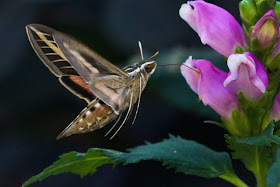If you’ve seen this creature or a variation of this creature
flitting around your garden recently, you may think it's a visiting hummingbird.
At first glance it’s natural to think you are looking at a
real live bird, but in fact it is an insect…a moth. It is the adult of several species of moths all grouped
under the general term hummingbird moths.
In its caterpillar stage, we call them hornworms; plump greenish caterpillars about the size of your
little finger with a wicked looking, but harmless, horn at one end.
Sampling blossom after blossom for the minute amounts of nectar in each, the Hummingbird Moth mimics a hummingbird, but there are real and
noticeable differences between the two.
First, the bird has two legs…the moth has six. The moth has a flexible proboscis which
is inserted into a flower whereas the hummingbird has a stiff bill and a long
tongue to lap up the liquid. As
small as a hummingbird is, it is still twice as large as the moth. Moths have antennae, hummingbirds do not. You might think you’re seeing a baby hummingbird, but baby hummingbirds don’t fly.
One nice characteristic of the Hummingbird Moth is its approachability. The moth seems less fearful of human
presence. If you maintain a
respectable distance the moth is likely to continue feeding in your
company…hummingbirds less likely.
If you have a good supply of flowers and nectar, the hummingbird moth may remain long enough for you to get a picture.
Allan




No comments:
Post a Comment